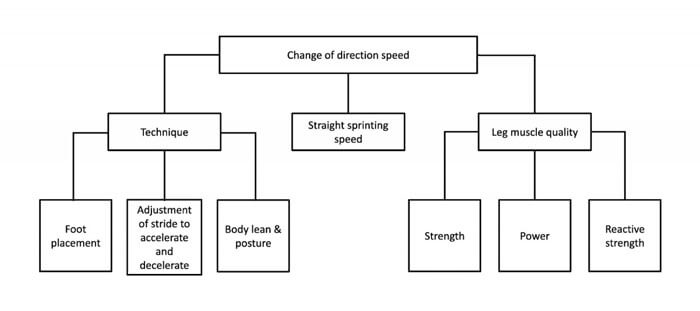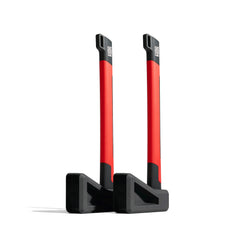In sports and physical training, acceleration is often the name of the game. It's what we usually think of when we try to improve speed and get faster.
How fast can you run?
How quickly can you get to the ball?
How soon can you finish those reps?
However, athletes and coaches alike tend to overlook the skill of deceleration. Slowing down, changing direction, or coming to a complete stop is equally as important as accelerating. Not only does proper deceleration make you a more agile athlete, it can also prevent injury.
Deceleration training effects not only direct speed, but improves the physical and technical components for you to get faster.

Source: SpringerOpen
So what exactly does deceleration training entail? Let’s look at the benefits of incorporating it into your routine and ways to do just that.
Benefits of deceleration training
Athletes tend to focus only on the first of these three movement types to get faster:
- Concentric - accelerate and create force production
- Isometric - stabilize and improve balance
- Eccentric - decelerate and decrease force production
Adding emphasis on the final two allow one to reap a number of benefits. "How efficiently muscles absorb force is what determines an athlete's ability to stop or change direction. Efficient deceleration is something all athletes can benefit from. It decreases the risk of injury and improves performance in sports. Getting stronger eccentrically and isometrically while also improving landing techniques are some surefire ways to make you a better decelerator," says Basi Prokofyev, a basketball development and sports performance specialist.
Let’s elaborate on what those benefits are.
Create explosiveness.
Explosiveness is necessary for both strength and speed. Incorporating deceleration training in the form of plyometric movements—exercises of great force over short periods of time—will help an athlete improve power.
“Explosive exercises, or exercises that test strength and speed, can improve physical performance during many fast-paced sports and may reduce an athlete's risk of injury during activities that involve high power outputs with quick acceleration, such as most racket and field sports,” says VeryWellFit.
Build strength.
“Strength is the ability of your nervous and muscular systems to produce enough internal force in your connective tissues and muscles to move an external force, such as weight or your body against gravity,” writes Livestrong. You can focus on strengthening different parts of the body that need additional attention.
Increase power.
Where strength doesn’t take into account the time it takes to perform an activity, power looks at strength in relation to time. Naturally, this is a key component to an athlete’s training regimen when you typically need to perform skills at quick pace and get faster.
Improve stabilization.
Stability is crucial to preventing injury. It’s at the foundation of every effective training program. Physical stability helps you keep your balance, where stabilization endurance helps with posture and maintaining stamina.

Source: National Academy of Sports Medicine
Prevent or rehab injuries.
Healing injuries starts by preventing them in the first place. Deceleration training is helpful in rehabbing injuries by slowing down the exercises that strengthen and lengthen the ligaments and muscles that tend to get hurt most often.
Who will best benefit from deceleration training?
In short: anyone. Performing exercises—particularly strengthening ones—at a slower pace are especially important in rehabilitation environments. Athletes especially need to focus on it because they need a mix of power, agility, balance, and strength. Particularly for athletes who run around a court or field, they need to be able to move gracefully and control their speed. While applicable to practically any sport, here are some specific examples where that rings true:
Tennis
Tennis matches can last anywhere from 90 minutes to a few hours—and they involve a lot of running. The ability to pivot movement quickly is key in order to hit the ball.
Studies have determined the importance of deceleration training in tennis players to not only improve agility but prevent common injuries in the shoulder and scapula:
"The lower body needs to perform large decelerations to prepare for and recover after groundstrokes and volleys, as well as during the follow-through and landing phase of the serve. The upper body, particularly the muscles of the upper back and posterior aspects of the shoulder, feature the major muscles that help decelerate the upper limbs after ball contact in serves, groundstrokes, and volleys. As such, deceleration needs to be considered a vital component of a competitive tennis player's training routine to achieve peak tennis performance."
Basketball
“Since basketball is played on such ‘a point A to point B’ basis, being able to get to those spots on the floor faster than your defender is a huge advantage in many ways,” writes Baller Bootcamp.
The ability to change direction and speed quickly is a trait of great basketball players, but it’s also crucial to preventing lower extremity injuries that are common in these types of athletes. Consider, too, that basketball players jump often and turn rapidly to follow the ball down the court. Focusing specifically on lower body deceleration exercises that strengthen the legs and create stability will help basketball players improve their game.
Soccer
Flexion in the ankles, hips, and knees is crucial to a soccer player’s ability to succeed on the field. Like tennis, soccer matches can last well into the multi-hour territory. And similar to basketball, these players are not only controlling a ball while running quickly, they’re often blocking other players or rapidly changing direction to get to the goal. A soccer field, bear in mind, is 115 yards long at regulation. The endurance created by slowing down strength and power movements in training is non-negotiable to the lifecycle of a great soccer player.
Conclusion
Deceleration training offers a range of benefits, but it’s not limited to athletes who play sports regularly. Anyone who trains—for personal, professional, or recreational reasons—can benefit from slowing, strengthening, and lengthening muscles in order to keep them healthy.
Deceleration training is a key focus for us at ChopFit, which is why our exercises and programming center around this idea. For more on deceleration and other aspects of our training methods, check out our Fitness Education materials and sign up for the Chopper Foundations Course.






